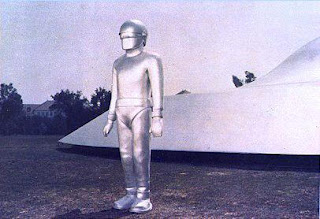 In a previous post I discussed the notion of alien Messiah or Christ figures that scholars and other commentators have seen in science fiction films. Of course, they have been seen in other genres as well, but my interest for the purposes of this blog is in relation to science fiction and related genres.
In a previous post I discussed the notion of alien Messiah or Christ figures that scholars and other commentators have seen in science fiction films. Of course, they have been seen in other genres as well, but my interest for the purposes of this blog is in relation to science fiction and related genres.
I have also mentioned how many writers have used The Day the Earth Stood Still (1951) as an example of this phenomenon, such as Anton Karl Kozlovic writing for the Journal of Religion and Popular Culture in an article titled “From Holy Aliens to Cyborg Saviors: Biblical Subtexts in Four Science Fiction Films.” However, I have also asked readers whether reassessment of such interpretations was in order. I am especially sensitive to this given my continued research into film studies as they relate to popular culture and theology, possibly as a prelude to future Ph.D. studies in this area. I am also preparing to co-teach a course on “Faith and Film” this summer at Salt Lake Seminary, and I want to ensure that I engage in responsible and rigorous scholarship in connection with this.
I have been assisted in rethinking these issues and in developing a more cautious methodology for interpretation through two sources. The first is Gordon Lynch’s book Understanding Theology and Popular Culture (Blackwell Publishing, 2005). As Lynch writes:
“An adequate dialogue between theology and popular culture thus requires what Michael Dyson has refered to as an ‘ethical patience,’ in which the theologian does not make hasty judgments about what they find tasteful or distasteful, or try to impose pre-existing concepts on to popular culture. One example of the latter are books and articles that attempt to identify ‘Christ-figures’ in contemporary film. To suggest, however, that Edward Scissorhands or the Preacher in Pale Rider are ‘Christ-figures,’ though is to impose Christian symbolism on to these movies in a way that fails to hear what these movies are saying on their own terms. Serious theological reflection on popular culture goes beyond te superficial identification of religious themes and symbolism within it to a more substantial dialogue between cultural texts and practices and wider theological questions and resources” (p. 38).
“Instead of concluding that a film is, or is not, theologically significant because of the perceived presence, or absence, of a Christ-figure motif, the theologian should be much more open to the possibility that a film does not require explicit or overt religious ideas or imagery in order to be amenable to religious or theological interpretations.”
And if this is the case perhaps we might also rethink not only the specifics of the Christ-figure (or lack thereof) in film, but other interpretations or emphases related to religion. For example, Douglas Cowan, previously interviewed on this blog on the topic of religion and terror, has submitted a proposal for a presentation at the American Academy of Religion’s national conference for 2007 with the title “The Deuteronomic Bargain: Religion, Fear, and The Day the Earth Stood Still” published in the Journal of Religion and Popular Culture as “Seeing the Savior in the stars: Religion, Conformity, and The Day the Earth Stood Still.” In this presentation he will, in part, challenge the dominant Christ-figure interpretation of Klaatu in the film to suggest that this figure more accurately reflects the character of Yahweh in Deuteronomy as recorded in chapter 30.
I hope that other readers will consider the need for evangelicals to reassess their interpretations and the methodologies that we use that lead to our views.





I find the emphasis on Christ figures strange.
I can think of tro stories where there is no obvious Christ figure, but which I think have religions significance.
One is Lord of the rings. I haven’t seen the film (I didn’t want anyone interfering with the opictures in my head when I read the book), but it is clearly a Christian book with no obvious Christ figure.
Another, which may not have been intended that way, yet reads like a Christian allegory, is Lord of the flies. When I first read it as an undergraduate, that was how it struck me that way. But again, there is no obvious Christ figure.
Actually I prefer my Christian fiction not to have Christ figures.